I’ve always thought bilge keels or bilge
fins or twin keels or whatever you want to call them were a
good idea. They are very practical for a number of reasons but
bilge keels never caught on in American for reasons I’ve
never quite understood. However, I was reminded of how practical
they are when I was in Britain recently and it’s rekindled
my interest.
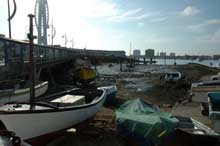
Photo 1 - Portsmouth Quay |
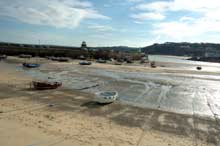
Photo 2 - St Ives Harbor
|
I was at Portsmouth Quay on my way to visit the
Museum and the HMS Victory when I noticed almost all the boats
by the ramp had bilge keels, even the power boats. Photos
1 and 2 are of Portsmouth Quay in
Portsmouth England and St Ives harbor on the Southwest coast
of Britain. These photos, taken at low tide, demonstrate the
need for something to keep your boat upright on the hard. I’m
told that on the East coast of Britain the problem is even more
extreme. The same large tidal range (8 to 10 feet or more) combined
with a gently sloping bottom. This is where Maurice Griffiths,
a British designer very fond of bilge keels, was from (more
on Griffiths later).
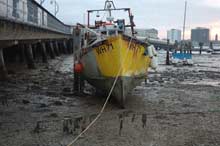
Photo 3 - Portsmouth Quay |
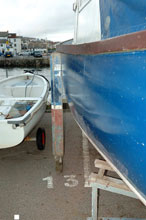
Photo 4 - Falmouth
|
Of course bilge keels aren’t the only solution
for the hard; the boat in photo 3, a 35 to
38 foot trawler type, uses pilings for support and the boats
in photo 4 and 5 use removable
legs. However, using pilings means you must come back to the
same mooring or another set of pilings. The legs, of course,
have to come off and on. Bilge keels, on the other hand, are
always there ready to take the hard even if you are not.
Both the trawler and the cruiser have keels to
protect the prop from the bottom. Dories and other flat bottom
boats generally lack keels and here is where bilge keels help
as well. In the Northeast coast of American and on the Canadian
East coast tunnels were and are built into the bottom and the
shaft and prop are lifted up inside the tunnel as the boat goes
aground. The Boat in photo 6 has solved this
problem with bilge keels or what might be more appropriately
called twin skegs. This boat, which looked something like a
Cobble, could just run up on the beach or tie off to a mooring
and not have to do anything.
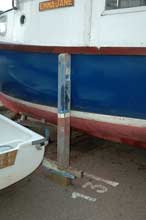
Photo 5 - Falmouth |
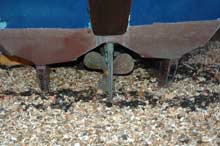
Photo 6 - Portsmouth
|
For power boats bilge keels can do more than
just protect the prop or keep the boat upright- they also help
dampen roll. The boat in photos 7
and 8 has bilge keels and while they help keep
the boat up right they also dampen the roll. There seems to
be various opinions about how much they dampen roll but everyone
agrees that there is a noticeable effect.
So for power boats bilge keels help the dampen
roll and help keep the boat upright but for sail boats they
also provide lateral resistance. Ted Brewer wrote a great article
in the January/February 1995 issue of Boatbuilder Magazine on
the use of “bilge fins”. He used the term “bilge
fins” because the “keel of a boat is the structural
backbone and runs from stem to stern; the part that sticks beneath
the hull to resist leeway in a modern sail is the fin.”
He points out in the article that a bilge fin boat can have
the same shoal draft as a keel/center board boat without all
the problems of the center board. He also points out that when
the boat heels over the bilge fin increases its draft because
the fins are angled out while the single fin has less draft.
He states the “Bilge fin hull is obviously more efficient
under sail” than a shoal keel of the same draft.
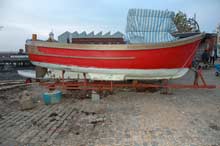
Photo 7 - Portsmouth |
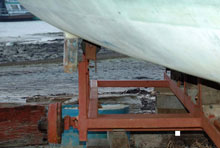
Photo 8 - Portsmouth
|
This agrees with the opinion of Peter Thomas
of Select Yacht Group in Britain. The Select Yacht Group are
builders of the Cornish Crabbers, Cornish Shrimper and the British
Hunter 20, a “twin keel” sail boat, among others.
Pete says “People seem to associate the name bilge keels
with poor performance so we use the term “twin keels”.
“We don’t tell people they’re sailing on a
twin keel boat and they always comment on how well the boat
points.” Pete isn’t the only one that feels twin
keel boats can sail to the windward as well as single fin boats
of the same draft. I spoke to several sailors at Falmouth, England
who feel the same way. They felt pretty strongly about it, actually.
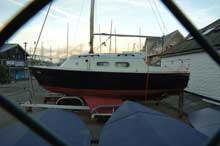
Photo 9 - Falmouth Harbor |
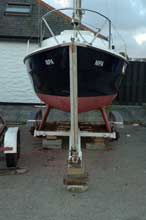
Photo 10 - Falmouth Harbor
|
Sailing well to the windward isn’t the
only positive performance trait the bilge keels have. According
to Eric Hiscock in Cruising
Under Sail, Maurice Griffith’s Lone
Gull ll, a bilge keel yacht, tracked very well and was
able “to hold her course unattended for long periods even
when running, and this is something which one does not usually
associate with shoal-draught vessels.” Another very positive
trait of Lone Gull ll was her “refusal to build up a rhythmic
roll under any conditions of wind and sea.” Other bilge
keel boats seem to exhibit this very desirable trait as well
and don’t show a tendency to broach in a following sea.
Certainly tracking well, not rolling, and resisting broaching
are what we all want in a good cruising boat.
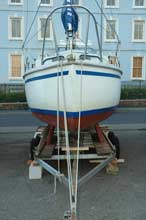
Photo 11 - Falmouth Harbor |
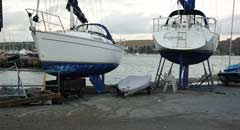
Photo 12 - Falmouth Harbor
|
There are some down sides to bilge keels, of course.
For example; they have more wetted surface than a single keel
boat, bilge keels don’t lend themselves to all types of
hulls, and they require hull support where the bilge keels attach
to the hull. These are small points, in my opinion, compared
to the benefits…. however every feature has its advantages
and disadvantages….everything is a compromise. The main
question is; do the advantages outweigh the disadvantages?
When I was at the harbor in Falmouth a boat count
showed about fifty percent of the boats had bilge keels. That
means a large number of sailors in Falmouth felt bilge keels
had more advantages than disadvantages. Photo 9
and photo 10 show a nice little cruiser with
a LOA of 22 to 24 feet and a draft of about 36 inches. It’s
sitting on a simple flat bed trailer that would be very easy
to launch and retrieve. In photo 11 a similar
sized bilge keel sail boat sits on another simple easy to build
trailer. Photo 12 helps demonstrate some of
the reasons bilge keels are so popular; the boat on the right
must have jacks and supports or some kind of cradle to stay
upright while the boat on the left requires nothing to stay
upright.
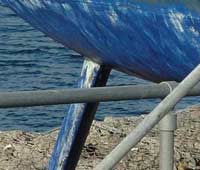
Photo 13 - Falmouth |
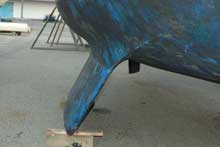
Photo 14 - Falmouth
|
Aside from the popularity of bilge keels I noticed
that there was a wide range of types and shapes of the bilge
keels. There was even variation in how the keel or fin was attached
to the hull. Some seemed to have no fairing at all, as in the
close up detail of photo 13. The opposite extreme
is photo 14, where the keel is faired into
the hull like an airplane wing. There were very thin fins (photo
15) to very fat keels (photo 16) and
this very shoal draft wooden lapstrake boat in photos
17 and 18.
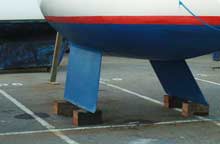
Photo 15 |
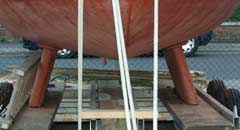
Photo 16
|
What all this variation says to me is that bilge
keels can be very tolerant and will do the job in a wide variety
of shapes and configurations. This may be one of the reasons
bilge keels are so popular in Britain and one reason American
builders should take a look at bilge keels. Are they right for
every boat? Of course not, I certainly wouldn’t use them
on an around the buoys racer. But a coastal cruiser or an open
daysailer, where shoal draft and good sea keeping abilities
are important, would be good candidates.
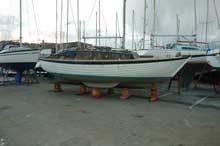
Photo 17 - Falmouth Harbor |
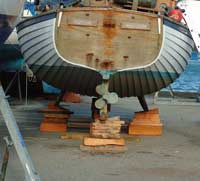
Photo 18 - Falmouth Harbor
|
Seeing the large number and variety of bilge keels
was an unexpected but educational part of my trip. And it certainly
has reminded me of all the advantages of bilge keels or bilge
fins, or twin keels or twin fins or whatever you wish to call
them.

